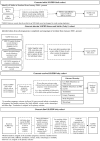Data resource profile: Scottish Linked Pregnancy and Baby Dataset (SLiPBD)
- PMID: 40151429
- PMCID: PMC11949196
- DOI: 10.23889/ijpds.v9i2.2390
Data resource profile: Scottish Linked Pregnancy and Baby Dataset (SLiPBD)
Abstract
Introduction: Here we present the Scottish Linked Pregnancy and Baby Dataset (SLiPBD), a new national data resource held by Public Health Scotland (PHS).
Methods: SLiPBD comprises a population-based e-cohort of all fetuses and births (babies) from pregnancies to women in Scotland from 2000 onwards. It is updated monthly by linking and reconciling the following national datasets: antenatal booking records; general and maternity hospital discharge records; termination of pregnancy notifications; and statutory live and stillbirth registrations.
Results: Key information included on all babies in SLiPBD includes estimated date of conception, end of pregnancy date, gestation, multiple pregnancy status, pregnancy outcome, and maternal sociodemographic characteristics. For live births, additional information on the birth, the baby's sociodemographic characteristics, and subsequent infant deaths is included.Following the cohort refresh in January 2024, SLiPBD contained 1,770,226 babies from 1,750,830 pregnancies to 898,161 women. Of the 1,770,226 babies, 1,284,461 (73%) were live births, 5,731 (0.3%) stillbirths, and 316,897 (18%) and 114,840 (6%) came from a pregnancy ending a termination or early spontaneous loss respectively. 22,414 (1%) had an unknown pregnancy outcome, and for 25,883 (1%) the pregnancy was still ongoing. Data completeness for key sociodemographic characteristics except for ethnicity was very high, and variables showed expected patterns. Ethnicity data completeness is poor on historical records but improving over time. Completeness of unique patient identifiers was very high. External validation to source datasets was reassuring.
Conclusion: SLiPBD can be analysed standalone or linked to other national vital event and health datasets held by PHS. It supports longitudinal and intergenerational analyses, enabling epidemiological and health service surveillance and research on maternal and child health. Researchers interested in accessing pseudonymised extracts of SLiPBD through the Scottish NHS safe haven facility should contact Research Data Scotland. PHS will continue to refine SLiPBD as source datasets improve.
Key features: The Scottish Linked Pregnancy and Baby Dataset (SLiPBD) is a new national data resource created and maintained by Public Health Scotland to facilitate epidemiological and health service analyses focused on maternal and child health.SLiPBD comprises a population-based e-cohort of all fetuses and births (babies) from pregnancies to women in Scotland from 2000 onwards. At least 68,000 babies (of which at least 46,000 are live births) are included annually.SLiPBD is updated on a monthly basis by linking and reconciling records relating to ongoing and completed pregnancies from the following existing national datasets: antenatal booking records; general and maternity hospital discharge records; termination of pregnancy notifications; and statutory live and stillbirth registrations.Key information included on all babies in SLiPBD includes estimated date of conception, end of pregnancy date, gestation, multiple pregnancy status, pregnancy outcome, and maternal sociodemographic characteristics. For live births, additional information on the birth, the baby's sociodemographic characteristics, and any subsequent infant deaths is included.Inclusion of unique personal identifiers for the mother and (where applicable) baby used within the health service and on statutory birth registration records ensures SLiPBD provides a core intergenerational spine record, allowing linkage between mothers and babies, and to other national datasets.Subject to governance approvals, researchers can access pseudonymised extracts of SLiPBD (linked to other national datasets as required) through the Scottish NHS safe haven facility, which is supported by Public Health Scotland. Interested researchers should submit an initial enquiry form to Research Data Scotland (https://www.researchdata.scot/accessing-data/).
Keywords: Pregnancy; administrative data linkage; administrative healthcare data; birth cohort; births; e-cohort.
Conflict of interest statement
Conflict of interests statement: No author has any conflict of interest to declare with regard to this paper.
Figures
Similar articles
-
Teenage pregnancy in Scotland: trends and risks.Scott Med J. 1991 Dec;36(6):172-4. doi: 10.1177/003693309103600604. Scott Med J. 1991. PMID: 1805377
-
Using routine data to examine factors associated with stillbirth in three tertiary maternity facilities in Kabul, Afghanistan.Reprod Health. 2025 Jan 3;22(1):1. doi: 10.1186/s12978-024-01916-9. Reprod Health. 2025. PMID: 39754203 Free PMC article.
-
Validating linkage of multiple population-based administrative databases in Brazil.PLoS One. 2019 Mar 28;14(3):e0214050. doi: 10.1371/journal.pone.0214050. eCollection 2019. PLoS One. 2019. PMID: 30921353 Free PMC article.
-
Cesarean section on request at 39 weeks: impact on shoulder dystocia, fetal trauma, neonatal encephalopathy, and intrauterine fetal demise.Semin Perinatol. 2006 Oct;30(5):276-87. doi: 10.1053/j.semperi.2006.07.009. Semin Perinatol. 2006. PMID: 17011400 Review.
-
Evaluation of Health in Pregnancy grants in Scotland: a natural experiment using routine data.Southampton (UK): NIHR Journals Library; 2017 Oct. Southampton (UK): NIHR Journals Library; 2017 Oct. PMID: 29035487 Free Books & Documents. Review.
Cited by
-
A maternal and child health administrative cohort in Scotland: the utility of linked administrative data for understanding early years' outcomes and inequalities.Int J Popul Data Sci. 2024 Nov 27;9(2):2402. doi: 10.23889/ijpds.v9i2.2402. eCollection 2024. Int J Popul Data Sci. 2024. PMID: 40200992 Free PMC article.
References
-
- Public Health Scotland’s privacy notice. 2022; Available at: https://publichealthscotland.scot/our-privacy-notice. Accessed 29 January, 2024.
-
- COVID-19 in Pregnancy in Scotland. 2023; Available at: https://www.ed.ac.uk/usher/eave-ii/covid-19-in-pregnancy-in-scotland/about. Accessed 29 January, 2024.
-
- Stock SJ, Carruthers J, Denny C, Donaghy J, Goulding A, Hopcroft LEM, et al.. Cohort Profile: The COVID-19 in Pregnancy in Scotland (COPS) dynamic cohort of pregnant women to assess effects of viral and vaccine exposures on pregnancy. International journal of epidemiology 2022;51(5):e245-e255. 10.1093/ije/dyab243 - DOI - PMC - PubMed
MeSH terms
LinkOut - more resources
Full Text Sources



